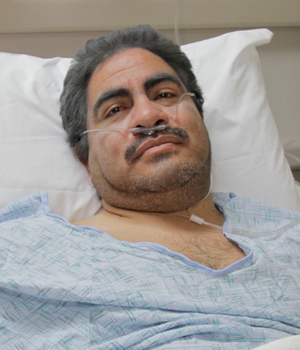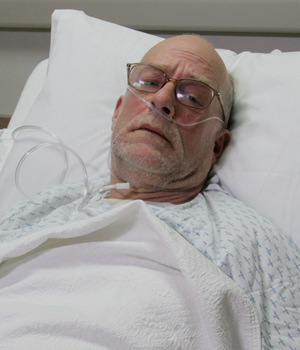15.8 Learning Activities
Open Resources for Nursing (Open RN)
Learning Activities
(Answers to “Learning Activities” can be found in the “Answer Key” at the end of the book. Answers to interactive activity elements will be provided within the element as immediate feedback.)
Scenario A
Mr. Smith, a 60-year-old male, was admitted to the general medical floor with a diagnosis of an exacerbation of heart failure. See Figure 15.17 for an image of Mr. Smith.[1] He has a past medical history of hypertension and coronary artery disease. His admitting weight was 225 pounds. His baseline weight from a previous clinic visit was 210 pounds. On admission, he had fine crackles throughout his lower posterior lobes and 4+ pitting edema in his lower extremities. His ABG results on admission were pH 7.30, PaCO2 50 mmHg, PaO2 80 mm Hg, HCO3- 27 mEq/L, and SaO2 85%.

Questions
1. Interpret Mr. Smith’s ABG results on admission.
2. Explain the likely cause of the ABG results.
3. Create a nursing diagnosis for Mr. Smith’s fluid status in PES format based on his admission data.
Mr. Smith has received multiple doses of IV diuretics over the past three days since admission. During your morning assessment, Mr. Smith tells you he very thirsty and feels dizzy. You notice he is irritable and is becoming increasingly confused. You quickly obtain his vital signs: BP 85/45, HR 110, RR 24/minute, O2 saturation 98% on 2L/min per nasal cannula, and temperature 37.2 degrees Celsius. His lung sounds are clear, and his heart sounds are regular sinus rhythm. You notice his weight this morning was 205 pounds. You call the provider and receive orders for STAT basic metabolic panel and to initiate 0.9% Normal Saline IV fluids at 250 mL/hour until the provider arrives to evaluate the client.
The basic metabolic panel results (with the lab’s normal reference range in parentheses) are as follows:
Sodium: 155 mEq/L (135-145)
Potassium: 3.3 mEq/L (3.5-5.3)
Chloride: 103 mEq/L (98-108)
Carbon dioxide: 25 mEq/L (23-27)
Blood urea nitrogen (BUN): 30 mg/dL (10-25)
Creatinine: 1.9 mg/dL (0.5-1.5)
Glucose: 100 mg/dL (fasting 70-99)
Questions
4. What is Mr. Smith’s fluid balance this morning? Support your answer with data.
5. What is the probable cause of his fluid balance?
6. Interpret Mr. Smith’s lab results. What are the potential causes of these results?
7. Create a nursing diagnosis statement in PES format for Mr. Smith’s current fluid status.
8. Create a new expected outcome in SMART format for Mr. Smith.
9. In addition to providing intravenous fluids, what additional interventions will you implement for Mr. Smith?
10. How will you evaluate if the nursing interventions are effective?
Scenario B
A 74-year-old male, Mr. M., was admitted to the general medical floor during the night shift with a diagnosis of pneumonia. See Figure 15.18 for an image of Mr. M.[2] He has a past medical history of alcohol abuse and coronary artery disease. You are the day shift nurse, and during your morning assessment, you notice that Mr. M. becomes increasingly lethargic and is not following commands consistently. You obtain the following vital signs: BP 80/45, HR 110, RR 8 and labored, O2 saturation 80% on 3L per nasal cannula, and temperature 38.1 degrees Celsius. His lung sounds reveal coarse crackles throughout, and you notice he is using accessory muscles with breathing. You notify the provider using an SBAR report and receive orders to increase oxygen to 10L per non-rebreather mask.

Lab results are ordered with the following results:
ABGs: pH 7.30, PaCO2 50, PaO2 59, HCO3 24, SaO2 80
Potassium: 5.9 mEq/L
Magnesium: 1.0 mEq/L
Calcium: 10.2 mg/dL
Sodium: 137 mEq/L
Hematocrit: 55%
Serum Osmolarity: 305 mmol/kg
BUN: 30 mg/dL
Urine Specific Gravity: 1.025
Questions
1. What is Mr. M.’s fluid balance? Provide data supporting the imbalance.
2. What is your interpretation of Mr. M.’s ABGs?
3. What is your interpretation of Mr. M.’s electrolyte studies?
4. Is Mr. M. stable or unstable? Why?
5. For what complications will you monitor?
6. Write an SBAR communication you would have with the health care provider to notify them about Mr. M.’s condition.
7. Create a NANDA-I diagnosis for Mr. M. in PES format.
8. Identify an expected outcome for Mr. M. in SMART format.
9. What interventions will you plan for Mr. M.?
10. How will you evaluate if your interventions are effective?
11. Write a nursing note about Mr. M.’s condition and your actions taken. This can be in the form of a DAR, SOAP, or summary nursing note.
Test your knowledge using this NCLEX Next Generation-style bowtie question. You may reset and resubmit your answers to this question an unlimited number of times.[3]
Test your knowledge using these NCLEX Next Generation-style questions. You may reset and resubmit your answers to the questions in this assignment an unlimited number of times.[4]
- “HF-RTD.JPG” by ARISE project is licensed under CC BY 4.0 ↵
- “Hospitalized Male” by ARISE project is licensed under CC BY 4.0 ↵
- “Chapter 15 Assignment 1” by Tami Davis for OpenRN is licensed under CC BY-NC 4.0 ↵
- “Chapter 15 Assignment 2” by Rebecca Wicks for OpenRN is licensed under CC BY-NC 4.0 ↵

